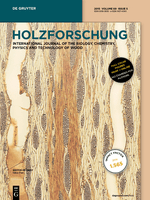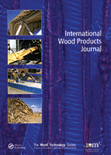
BioResources
Scope & Guideline
Pioneering research for a greener tomorrow with biomaterials.
Introduction
Aims and Scopes
- Biomass Utilization and Conversion:
Research focuses on the conversion of various biomass materials into value-added products, including biofuels, bioplastics, and other biochemicals, utilizing sustainable methods. - Wood Science and Technology:
Studies on the physical, mechanical, and chemical properties of wood and wood-based products, including their processing, treatment, and performance under various conditions. - Nanotechnology Applications in Biomaterials:
Explores the use of nanomaterials and nanotechnology in enhancing the properties of bio-based materials, including their potential applications in packaging, coatings, and composites. - Environmental Impact and Sustainability:
Research addressing the environmental implications of biomass utilization and wood processing, including life cycle assessments, carbon footprint analysis, and sustainable forestry practices. - Innovative Processing Techniques:
Investigates novel methods for biomass processing, including advanced extraction techniques, biorefinery approaches, and the development of eco-friendly treatments for wood and biomass. - Bioproduct Development:
Focuses on the design and development of new bio-based products, including adhesives, coatings, and composites, derived from renewable resources.
Trending and Emerging
- Sustainable Biocomposites:
Research on biocomposites that utilize renewable materials and minimize environmental impact is gaining momentum, driven by the demand for eco-friendly alternatives in various industries. - Advanced Biomass Pretreatment Techniques:
Emerging studies focus on innovative pretreatment methods that enhance the efficiency of biomass conversion processes, making them more viable for commercial applications. - Machine Learning and AI in Biomaterials:
The integration of machine learning and artificial intelligence in predicting material properties and optimizing processes is becoming a prominent theme, showcasing the intersection of technology and biotechnology. - Circular Economy Approaches:
Research is increasingly addressing circular economy principles, focusing on waste reduction, resource recovery, and sustainable practices in the forestry and biomass sectors. - Lignin Valorization:
The exploration of lignin as a valuable byproduct in various applications, including adhesives, coatings, and biofuels, is trending significantly as industries seek to maximize resource efficiency. - Green Chemistry and Processing:
There is a growing emphasis on green chemistry principles in the development of bio-based materials, focusing on environmentally friendly processes that reduce chemical waste.
Declining or Waning
- Traditional Wood Processing Techniques:
Research on conventional methods of wood processing is becoming less prevalent as innovative technologies and more sustainable practices gain traction. - Single-Use Bioplastics:
As the emphasis shifts towards sustainable and reusable materials, research on single-use bioplastics is decreasing, reflecting a broader industry move away from disposable products. - Chemical Pulping Processes:
Interest in chemical pulping methods appears to be waning, likely due to a greater focus on mechanical and environmentally friendly alternatives that minimize chemical usage. - Non-renewable Resource Utilization:
There is a noticeable decline in studies focusing on the use of non-renewable resources in bioproduct development, as the sustainability agenda gains more attention.
Similar Journals

Biofuels Bioproducts & Biorefining-Biofpr
Advancing Sustainable Solutions in Biofuels and BeyondBiofuels Bioproducts & Biorefining (Biofpr), published by WILEY, stands at the forefront of research dedicated to the sustainable production and utilization of biofuels and bioproducts. With its robust impact, as evidenced by its placement in the Q2 quartile across both Bioengineering and Renewable Energy, Sustainability and the Environment categories, this journal provides a vital platform for disseminating high-quality research aimed at advancing bio-refining technologies and bio-product innovations. Covering a wide range of topics from production methodologies to environmental impacts, Biofpr serves as an essential resource for researchers, professionals, and students eager to contribute to the evolving领域 of renewable energy solutions. Its consistent performance in the Scopus rankings further underscores its importance, ranking #78 in Renewable Energy and #51 in Chemical Engineering, making it an indispensable read for those committed to sustainability and scientific advancement in the biofuels sector.

HOLZFORSCHUNG
Innovating biomaterials through wood research.HOLZFORSCHUNG is a distinguished journal in the field of biomaterials, published by WALTER DE GRUYTER GMBH and based in Berlin, Germany. With an ISSN of 0018-3830 and an E-ISSN of 1437-434X, this journal has been a key player in advancing the understanding of wood research and its applications since its inception in 1947. As of 2023, it holds a Q3 ranking in the biomaterials category, positioned at #77 out of 137 in Scopus, reflecting its growing reputation within the academic community. Although it does not currently offer open access, HOLZFORSCHUNG aims to bridge the gap between theoretical research and practical applications, providing valuable insights for researchers, professionals, and students alike. With a focus on innovative studies and contributions to the understanding of wood as a biomaterial, it remains integral to the discourse in materials science.

JOURNAL OF WOOD CHEMISTRY AND TECHNOLOGY
Advancing Sustainable Solutions in Wood ChemistryJournal of Wood Chemistry and Technology, published by Taylor & Francis Inc, is a premier academic platform dedicated to advancing the fields of wood chemistry and technology since its inception in 1981. With an impressive converged publication run extending through 2024, this journal addresses pivotal research in chemical engineering and materials science, achieving a current categorization in Q2 for both Chemical Engineering and Chemistry, alongside a Q3 ranking in Materials Science. As evidenced by its Scopus rankings, it occupies a respectable position within the academic community, fostering discussions that bridge theoretical innovation and practical applications relevant to the industry. While access is not open, the journal remains an essential resource for researchers, professionals, and students eager to explore the complexities of wood chemistry, enhancing their understanding and contributing to sustainable practices in materials development.

WOOD RESEARCH
Pioneering Research in Wood Technology and SustainabilityWOOD RESEARCH is a premier academic journal published by the SLOVAK FOREST PRODUCTS RESEARCH INSTITUTE, dedicated to advancing knowledge in the fields of forestry and material science. With an ISSN of 1336-4561, this journal serves as a vital resource for researchers and professionals seeking to explore innovative research, advancements in wood technology, and sustainable practices related to forest products. Recognized for its quality, WOOD RESEARCH holds a Q2 ranking in the field of Forestry and a Q3 ranking in Materials Science according to the latest metrics, indicating a robust contribution to these disciplines. The journal is committed to open access options, ensuring that findings are accessible to a global audience, thereby fostering collaboration and knowledge sharing. Established in 2003 and operating through to 2024, it continues to play a significant role in shaping the future of wood research, offering insights that are essential for students, academics, and industry leaders alike. For detailed submissions and research discussions, the journal can be accessed through its dedicated platform, contributing to an enriched academic dialogue in Slovakia and beyond.

MOKUZAI GAKKAISHI
Connecting Scholars to the Future of Wood ScienceMOKUZAI GAKKAISHI, a prestigious journal published by the Japan Wood Research Society, serves as a critical resource for scholars and practitioners in the field of wood science and technology. With an ISSN of 0021-4795 and an E-ISSN of 1880-7577, this journal has been a pivotal platform since its inception in 1949, focusing on a broad spectrum of topics including wood materials, wood processing, and sustainable forestry practices. Although it does not currently offer open access options, its rigorous peer-review process ensures high-quality research dissemination. As researchers and professionals delve into the complexities of wood science, MOKUZAI GAKKAISHI stands out as an essential academic journal that informs, engages, and inspires innovative solutions in wood utilization and conservation efforts. The journal's historical significance and ongoing contributions make it a staple reference for anyone looking to advance their understanding of wood-related research and applications.

International Wood Products Journal
Shaping the Future of Forestry Through ResearchInternational Wood Products Journal is a premier academic publication dedicated to advancing knowledge in the fields of forestry and materials science. Published by SAGE Publications Inc, this journal serves as a critical forum for researchers and professionals alike, focusing on innovative developments and sustainable practices related to wood and wood products. With an impressive impact factor that places it in the Q2 category for forestry and Q3 for materials science in 2023, it showcases high-quality research that influences policy and practice. Covering a wide scope from 2010 to 2024, the journal offers insightful articles and reviews that highlight the latest findings and technological advancements in wood products. Notably indexed in Scopus, it ranks 69th out of 174 in Forestry and 296th out of 463 in General Materials Science, attesting to its relevance and contribution to these fields. Researchers and students are encouraged to explore this journal for cutting-edge information and collaborative opportunities within the international wood products community.

Scientia Forestalis
Connecting scholars and practitioners for impactful forestry studies.Scientia Forestalis is a prominent academic journal dedicated to advancing the field of forestry and environmental studies. Established in 1996 and published by the Instituto de Pesquisa e Estudos Florestais (IPEF) in Brazil, this journal provides a critical platform for researchers and practitioners to disseminate innovative studies and findings in forestry. With an HIndex reflective of its academic impact and ranking in the third quartile of forestry journals, Scientia Forestalis is positioned to cater to a diverse audience, including scholars, professionals, and students engaged in agricultural and biological sciences. Despite its non-open access model, the journal maintains a commitment to high-quality research that fosters an understanding of forest ecosystems and sustainable practices. Published articles span a wide range of topics, ensuring that crucial developments in forestry science are captured and shared. The journal's current Scopus rank places it within the 26th percentile, affirming its role in shaping forestry research in a global context, making it an essential resource for anyone interested in this vital field.

FOOD AND BIOPRODUCTS PROCESSING
Innovating solutions for global food security challenges.FOOD AND BIOPRODUCTS PROCESSING, published by Elsevier, is a leading journal dedicated to advancing the fields of biochemistry, biotechnology, chemical engineering, and food science. With a strong impact factor and robust rankings—Q2 in Biochemistry and Biotechnology, and Q1 in Food Science—it serves as an essential resource for researchers, industry professionals, and students alike. The journal focuses on innovative research and practical applications in the processing of food and bioproducts, spanning from raw material transformation to product development. By fostering the exchange of knowledge and ideas, FOOD AND BIOPRODUCTS PROCESSING aims to enhance food quality and sustainability while addressing global challenges in food security and environmental impact. With an accessible format and a diverse pool of contributors, this publication stands as a vital platform for groundbreaking studies, making significant contributions to the advancement of technology and practices in food processing and production.

Acta Facultatis Xylologiae Zvolen
Championing excellence in forestry scholarship.Acta Facultatis Xylologiae Zvolen, an esteemed journal published by TECHNICKA UNIV ZVOLENE, serves as a pivotal platform for the dissemination of research within the field of Forestry. With an ISSN of 1336-3824, this journal has been consistently delivering scholarly articles since its inception in 2007. It is recognized in Scopus, placing it in the Q3 category among its peers in Agricultural and Biological Sciences, specifically in Forestry, wherein it ranks #80 out of 174 with a 54th percentile. Although currently not open access, it provides critical insights and high-quality research that are invaluable for professionals, researchers, and students engaged in forestry and related disciplines. Readers can expect to find articles that delve into contemporary issues, innovative methods, and emerging trends within the field, making it an essential resource for anyone devoted to advancing the science of forestry.

International Journal of Engineering Research in Africa
Fostering Knowledge, Driving ProgressThe International Journal of Engineering Research in Africa is a pivotal academic resource for researchers, professionals, and students interested in the multifaceted field of engineering within the African context. Published by TRANS TECH PUBLICATIONS LTD, this journal facilitates the dissemination of innovative research, covering a myriad of topics in engineering, from advanced materials to sustainable practices. With an ISSN of 1663-3571 and E-ISSN 1663-4144, this publication not only fosters scholarly communication but also contributes to the global engineering discourse, as evidenced by its current Q3 ranking in the Engineering (miscellaneous) category in 2023. Operating from its base in Switzerland, the journal has been actively publishing since 2010 and continues to play a vital role in the advancement of engineering knowledge, particularly in the African landscape. Although it does not offer an open access model, the journal's commitment to quality research ensures that it remains a valuable asset for those seeking to understand and innovate within the engineering sector. Its integration in Scopus with a rank of #175 out of 307 in General Engineering further underscores its relevance and impact in the engineering community.